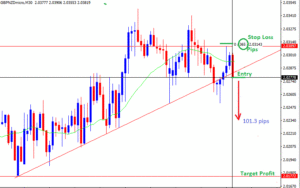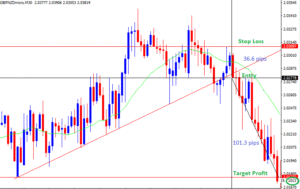You can Calculate Risk Reward Ratio in Forex using the stop loss and target profit values.
So, Simply divide the amount you are willing to lose by the amount expected to earn when you close your position.
It is how much you are willing to expose to the market in relation to how much you expect to make from the market for each trade you take.
Stop loss is the entry price subtract the stop loss price.
Take profit is the target price level of exit minus the entry price.
Let’s look at an example below with small channel breakout to downside;

The signal for the Sell entry was candle close below the channel trend line support.
Risk is the distance from the entry price to the stop loss price and reward is the distance from entry price to the target/ exit price level.
To calculate Risk reward ratio in forex in the above example, It is the amount of risk divided by the reward.
How to calculate Risk Reward ratio for your trade
When you have the entry point, you can set your risk using the stop loss target level.
Your trade will automatically close as soon as it reaches that level. In other wards, your trade will close with a loss (Stop Loss).
On the other hand, to determine your reward set a target profit level.
Certainly, your trade will close automatically when the price level is hit . For price to reach your target profit, price must move to your predicted direction.
Risk to reward ratio formula = (Take Profit – Entry ) / (Entry – Stop loss) or
Stop Loss in pips/ Target Profit in pips
Below is an example on GBP/NZD, 30 Min chart.


Risk to reward ratio = (Stop loss in pips/ target profit in pips)
= (36.6/101.3)
= 1:3
Alternatively, you can use; (Take Profit price – Entry price ) / (Entry price– Stop loss price)
When you calculate your risk to reward ratio, you will be able to decide whether the trade is worth taking or not.
If the trade give great ratio according to your plan, you can go ahead and take it. Or else, leave the trade and wait for another set up.
Always set targets that are more reasonable and attainable.
This helps you to increase on the chances of trade success and still able to cover up your losses even if the number of times you lose are more than the number of wins.
However, you should not make your stop loss very tight next to your entry point and your take profit very wide.
Your stop loss should give enough room for the market to breath.
how important is this ratio
For instance, if I want to risk 1% of my $3000 account per trade. My goal is to make 3 times the risked money.
This simply means my risk to reward ratio is 1:3.
If a trade goes against me, I lose 1% of my account and if the trade goes to my favor, I make 3% of my account i.e 3 times the amount I have risked.
Understanding the risk to reward ratio and how it applies to each trade improves your trading.
The kind of ratio you choose to use should be in line with the probability rate of success of your trades.
Therefore, before jumping in any trade, assess the trade and see if it is worth taking or not.
First ask yourself these questions and if you have ready answers, you can go ahead and take the trade.
- Where is the entry point for the trade? Have I identified the entry? If yes,
- Where do I put the stop loss?
- Where do I put my target profit?
- What is my risk to reward ratio?
- Last but not least, Is it worth taking this trade? If yes, go ahead and take the trade. If not, wait for another opportunity and repeat the same procedure
In the later lessons, we will learn how to set appropriate stop losses while keeping the reward large enough.
In conclusion
When you look at your system’s performance, you should be able to tell what risk reward ratio is tolerable in your plan.
It could be 1:1, 1:2 or 1:5 but at least keep it at a minimum of 1:2
You can test your system as many times on a demo.
Make a journal to assess the performance and degree at which the setups taken have hit your stop loss or take profit targets.
There you will know if you are using the appropriate risk to reward ratio for your strategy.
Risk to reward ratio can be adjusted depending on the trading range, time frame Price Volatility and your entry and exit points.
How procrastination can affect your trading success?
Procrastination to trade is when your trading set up confirms and you hesitate to take trade. Or your trade show all failing signals and you hesitate to close trade to cut losses. Also, in cases, where you sometimes hesitate to take profit because you want to...
- Oh, bother! No topics were found here.



